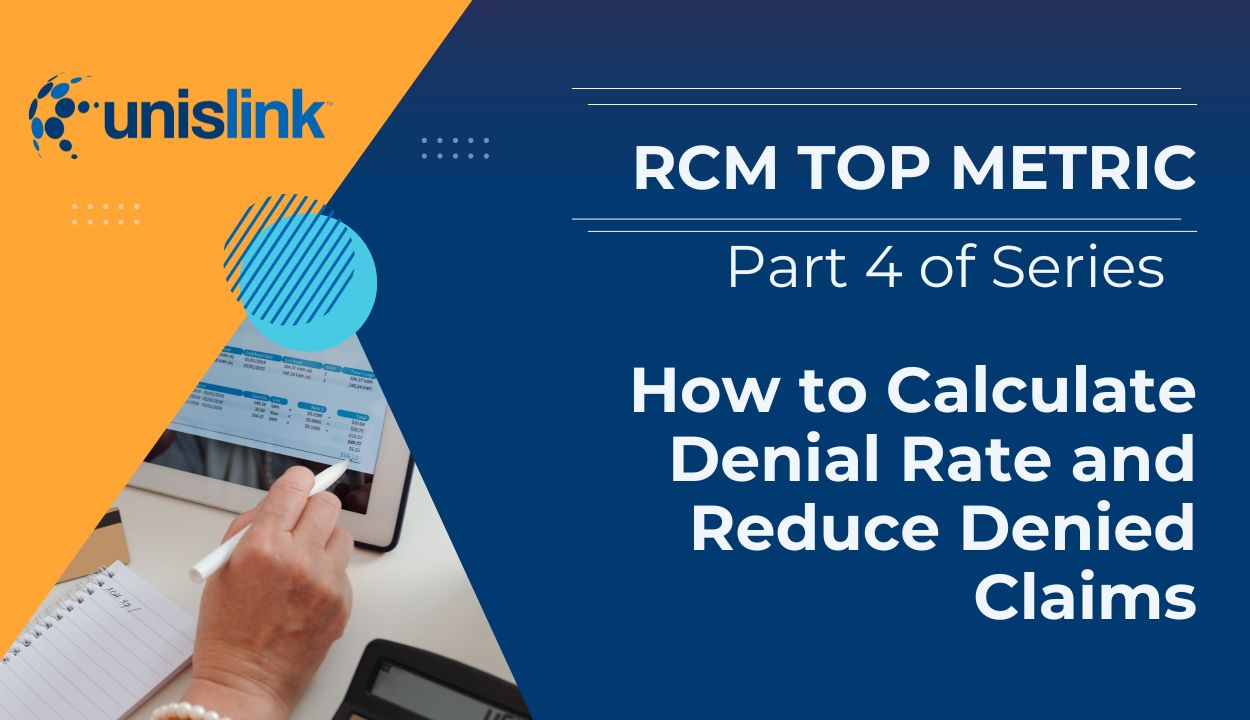This article on Calculating Denial Rates is Part 4 in our series on Tracking Top RCM Metrics:
Part 1: Seven Most Important RCM Metrics That Every Medical Practice Should Monitor
Part 2: How to Improve Cash for Your Medical Practice by Tracking Days in A/R
Part 3: Why Average Revenue Per Encounter is Important for a Medical Practice
Part 5: Monitoring Gross Collection Rate, Revenue Realization Rate, and Net Collection Rate
Monitoring your practice analytics is essential for high performing revenue cycle management (RCM). Among the most telling of all RCM metrics is your rate of denial of medical claims you’ve submitted to health insurance companies. High denial rates are silent revenue leaks to your organization—possibly undetected until they start to significantly affect your bottom line.
When healthcare providers regularly calculate claim denials and interpret this metric, it gives them a clear path to increasing cash flow, optimizing performance, and reducing administrative waste.
In this article, we’ll help you learn to calculate your medical claim denial rate, why it’s important, what industry benchmarks to strive for, and how to reduce your denial rates over time.
Healthcare Industry Formula for Calculating Denial Rate
Use the following formula to calculate your overall denial rate.
Formula for Denial Rate:
Denial Rate = Number of Denied Claims ÷ Total Claims Submitted
Example: If your practice submitted 7,500 claims last month and 1,500 of them were denied, your denial rate is:
1,500 ÷ 7,500 = 0.20, or 20% denial rate
This number alone should trigger a red flag. But to get more actionable insight, it’s best to break this into two categories:
1. Calculate Initial Denial Rate
This is the percentage of claims denied on first submission, before any rework or appeals. It reflects how well your practice captures data, verifies eligibility, codes claims, and submits clean claims the first time.
Initial Denial Rate = Number of Claims Denied on First Submission ÷ Total Claims Submitted
2. Calculate Final Denial Rate
This is the percentage of claims that remain denied after all follow-ups and appeals have been completed. This number represents true revenue loss.
Final Denial Rate = Number of Claims Still Denied After Appeals ÷ Total Claims Submitted
Industry Benchmarks for Denial Rates
When interpreting your denial rate from insurance companies, look at Denial Rate Type, Industry Average, and Top-Tier Benchmark.
Here’s a Guidepost for Industry Standards:
1. Initial Denial Rate
Industry Benchmark: 6% – 10%; Top Tier Benchmark is <5%
2. Final Denial Rate
Industry Benchmark: 2% – 5%; Top Tier Benchmark is <2%
A high-performing healthcare organization should aim to keep both initial and final denial rates as low as possible, with special attention paid to initial denials, which are easier and faster to correct if caught early.
Why Calculating Denial Rate is Important to Healthcare Providers
Even a few percentage points above the industry benchmark can mean tens, or hundreds of thousands of dollars in lost revenue per year from medical billing. Here’s how denial rates directly impact the revenue cycle:
- Cash Flow Delays: Denied claims will delay your payments and interrupt predictable cash flow cycles.
- Increased Operational Costs: Every denied claim requires staff time to investigate, correct, and resubmit, driving up administrative costs.
- Reduced Reimbursement Rates: Some payers reduce allowable amounts on corrected claims, meaning even successful appeals don’t recover the full amount.
- Patient Satisfaction Impact: High claim denial rates tied to eligibility or authorization issues can lead to patients being surprised by unexpected bills, decreasing trust and satisfaction.
The Most Common Reasons Medical Claims are Denied
Analyzing the root causes of your claim denial rate is the first step in fixing them. Here are the most common reasons claims are denied:
- Patient eligibility issues (e.g., inactive coverage, incorrect plan codes)
- Missing or incorrect prior authorization
- Incorrect patient demographics or insurance company details
- Coding errors (e.g., mismatched diagnosis and procedure codes)
- Lack of medical necessity documentation
- Timely filing violations for medical billing
- Duplicate claim submission
- Out-of-network provider or location
- Other violations of payer requirements
A denial management strategy should begin with analyzing denial reasons by payer, service type, and provider.
Top Ways Healthcare Providers Can Improve their Denial Rate
Reducing the volume of denied claims is about building a proactive, data-driven RCM process that catches errors before claims go out the door. Here are some proven best practices:
1. Patient Eligibility Verification
Perform real-time eligibility checks for valid health insurance before every visit. This ensures active coverage, correct plan info, and valid coordination of benefits.
2. Preauthorization Management
Automate and track preauthorization requirements by insurance payer and procedure. Missed authorizations are a major source of denials. Incorporate best practices in RCM teams for consistency.
3. Clean Data Capture
Use front-desk checklists and EHR-integrated forms to ensure accurate patient demographics and insurance details are collected.
4. Medical Coding Accuracy
Invest in certified medical coders or outsource to a medical coding company that stays current with CPT, HCPCS, ICD, and payer rule updates. Leverage technology tools that flag incomplete or incorrect coding in real time.
5. Insurance Claim Scrubbing & Edits
Use RCM software or billing systems with rules engines that scrub insurance claims for missing fields, coding mismatches, and payer-specific nuances before submission.
6. Monitor Denial Trends
Set up dashboards and reports to monitor your denial rate by payer, provider, procedure, and reason code. Weekly and monthly reviews help you catch new trends early and keep the focus on denial prevention.
7. Staff Training & Accountability
Provide ongoing training for front desk, billing, and coding staff. Tie team metrics (like clean claim rate and first-pass resolution) to performance goals, and provide corrective actions.
8. Timely Follow-Up & Appeals
The team should work on denied claims within 24–48 hours. Appeals should be based on documented policies, clinical records, and payer-specific language. Strong follow-up processes with insurance companies can reduce the rate of denials.
KPIs to Watch that are Related to Denied Claims
Tracking your denial rate is important, but pairing it with related key performance indicators (KPIs) gives deeper insight into your revenue cycle’s performance:
- Clean Claim Rate: Percentage of claims accepted without edits or denials.
- First-Pass Resolution Rate: Claims paid on first submission without intervention.
- Days in Accounts Receivable (A/R): How long it takes to get paid after claim submission.
- Appeal Success Rate: Percentage of denied claims successfully overturned.
These RCM metrics work together to reveal the health of your billing operations—and where your biggest opportunities for revenue improvement lie.
Watch our most popular RCM improvement video: The Power of KPIs
The Role of Technology and Automation in Reducing Denied Claims
Today’s modern healthcare RCM technologies incorporate AI and automation technologies that can flag errors before claims are submitted. These newer systems dramatically improve efficiencies at the practice level, saving time and improving cash flow.
Here’s a sampling of the newer tools and systems that help a medical practice reduce denial rates:
- Patient Eligibility & Preauthorization Software
- Claim Scrubbing Tools with Payer Rules Engines
- AI-Based Predictive Denial Analytics
- Automated Denial Work Queues
- Real-Time Key Performance Indicator (KPI) Dashboards
Investing in these systems can reduce manual errors, enhance productivity, and free up your staff to focus on complex exceptions and better patient experience.
The Only Long-Term Strategy
The only long-term strategy for significantly reducing denials is to prevent them from happening in the first place. To accomplish that we have to get to the root cause and prevent it.
Step one is implementing a denial review process that measures the denials we’re getting, and prioritizing them by impact and importance. We do this to work on denials that will have the greatest positive impact on financial performance.
Unfortunately, this rarely happens in smaller organizations where the same person doing the appeals is also expected to provide the feedback, mostly because 70% of practices are understaffed and the workload feels overwhelming.
Staff members that fully intend to analyze root-causes struggle to dig deep into the problem because they are too busy working the daily denials. The operation becomes an endless treadmill of reacting to claim denials instead of fixing the root cause.
The best way to get off this treadmill of losing money to denials is to dedicate resources specifically for the purpose of prevention – meaning assigning a person whose only job is to fix the root causes of denials. And for many healthcare practices, this is an extra RCM expense in a challenging financial environment. When a practice chooses not to make the investment in denial prevention, they are destined to be on the never ending treadmill of chasing denied claims.
How UnisLink Can Help Reduce Denials and Increase Your Cash Flow
At UnisLink, our end-to-end revenue cycle management services are designed to drive performance across every stage of the claim lifecycle. We proactively reduce denial rates through:
- Eligibility Verification & Preauthorization Tracking
- Certified Medical Coding Services
- Custom Claim Scrubbing Rules
- Automated Claim Submission & Status Monitoring
- Dedicated Insurance Follow-Up Teams
- Denials Management and Appeals
- Insurance Discovery
- Implement a Denial Feedback Loop That Identifies and Prevents Denial Root Cause
Whether you’re struggling with persistent payer denials or looking to increase your clean claim rate, our technology-enabled services and expert teams help healthcare providers improve cash flow, optimize staff resources, and reclaim lost revenue.
Final Thoughts on Improving Your Denial Rate
Denial rate isn’t just another data point—it’s a mirror reflecting the strength of your revenue cycle. A high denial rate drains resources, delays payment, and undermines practice growth.
By understanding what denial rate is, how to calculate it, and how to improve it, healthcare providers can turn this KPI into a powerful lever for increasing revenue and streamlining operations.
Contact us today and start tracking, start optimizing, and start keeping more of what you earn.

